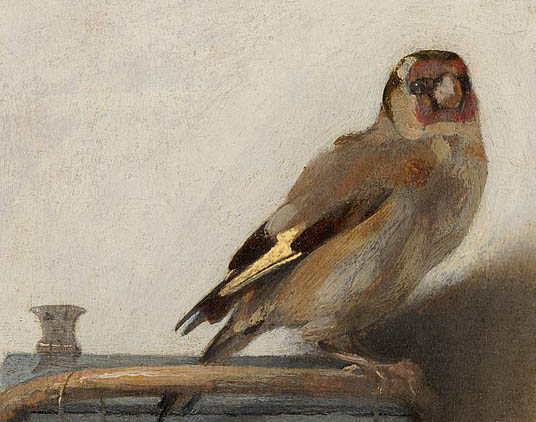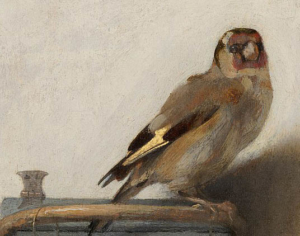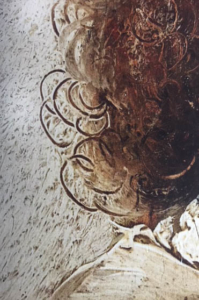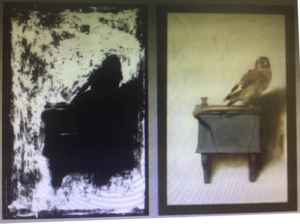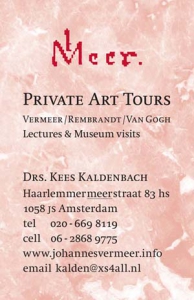Some thoughts on The Goldfinch by Fabritius in the Mauritshuis.
By Drs Kees Kaldenbach, art historian, after a visit to the museum in Kassel, Germany, 2018.
Mauritshuis Zoom private visit
A small but arresting painting catches the eye in the Mauritshuis museum, in The Hague, just after leaving the room with the three Vermeer paintings. On a nearly white background we see a wooden box, that functions as a seed container, with a wooden lid on top, and a protruding copper tubing, on which a pretty but chained small pet bird is perched.
It is a prime example of a trompe l’oeil or in Dutch: ‘bedriegertje’, a painting intended to deceive the eye. Most paintings in that class of trompe l’oeil are photographically real and very detailed, by this one by Carel Fabritius stands out for its painterly roughness. The soft shadow and the reflections on the two brass perching bars give it a strong 3D character. The picture is signed and dated: C Fabritius, 1654. It was the year of his terrible death due to falling walls and roof in the gunpowder explosion in Delft.
The man who brought many Vermeers back into public knowledge (most were mis-labeled at that time, around 1880) was Théophile Thoré aka Bürger. This talented art connaisseur recognised the outstanding quality of this Goldfinch painting and received it from an heir, a few years after the former owner, mr Camberlyn had passed away. Un chardonneret perché sur sa petite case d’esclave…”.
We may consider this fantastic image of a bird on three levels: On a painterly level, on a factual level, and finally on a moral level.
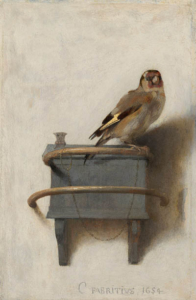 Painterly: We see a close cousin to Frans Hals’ style in the free and expressive handling of the paint surface in the bird itself. We also see the 3D qualities in the whole scene due to the soft shadow.
Painterly: We see a close cousin to Frans Hals’ style in the free and expressive handling of the paint surface in the bird itself. We also see the 3D qualities in the whole scene due to the soft shadow.
It entices the viewer to go for it: to buy some paint and a canvas, and start painting, just for the sheer joy. It looks easy, so it should be easy. Let’s start! The Mauritshuis web site mentions the yellow feather in which Fabritius scratched a line with a woorden stick (back side of a brush?) revealing the dark paint below. This is a trick of the trade also used by Rembrandt in his Self portrait in the Rijksmuseum. A source mentions Fabritius as a pupil of Rembrandt.
Factual: This is a well-trained pet bird, able to lower a small bucket on a separate chain, down into a container (tub? glass?) of water down below. That tiny bucket is probably ticket away under the lid to the grey box, and can be opened by the master/mistress or the goldfinch itself. The bottom copper rail is an afterthought of Fabritius. Purely technically speaking: a present day hardware store would hardly be able to sell us the intricate parts necessary to fix it firmly to the plaster wall. The label mentions the Dutch title: Puttertje, which translates into little well-water-fetching-bird.
X-rays and other technology tell us that the painting once had a painted dark edge around all four edges. In the present day museum setup, the top dark part is a result of a badly placed overhead spot light. Move your hand to the light source and you will see that the whole surface is nearly white.
Technical research also shows that the panel was once part of a peep show box. There is too little to go on to make a serious mock-up. In the image to the right we see an x-ray and a photoshop version of the painting as it once may have looked, without the added bottom brass rail.
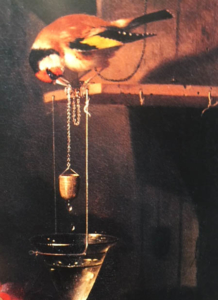
Abraham Mignon, detail in a flower painting, showing a Goldfinch in action. This is a reproduction on a post card sold in the shop.
In Kassel, in the Old Masters Gallery on the hill, is a remarkable companion bird: It shows an active finch on the far right hand side in a big, about 1 m wide flower painting by Abraham Mignon (1640 – 1679). The painting was bought in 1750 by the local ruler Wilhelm VIII, remarkably from the Cabinet of Valerius Röver, Delft. The whole flower painting is reproduced on the museum web site here.
The given German museum title in that web site, GK 445, Früchtestillleben mit Eichhörnchen und Distelfink is a bit strange in that Distel/Thistle is only a bird nickname, due to the enthusiasm of this bird for thistle seeds. Its proper name is Goldfinch.
This Kassel painting is however highly helpful and instructive for understanding the Carel Fabritius painting. The one in Kassel shows the bird in the act of fetching water. That is a result of endless hours of enticing, rewarding, prodding, training and perseverance. Which brings us to the moral element: Only after serious training and added willpower does one get to a worthwhile result in life. A lesson for the young and the old.

Abraham Mignon, detail in a flower painting, showing a Goldfinch. This is a detail of the reproduction found online.
Go to private lectures for
Vermeer AtHome
Vincent van Gogh AtHome
Rembrandt AtHome
Join in with a private tour by Drs Kees Kaldenbach, a professional Art History scholar with excellent teaching skills (so they say). Specialist in Fine art and Design, Architecture and History. VIP entry. Entry best at 10 AM.
Kaldenbach: he is wildly overqualified to be a guide . That is his secret. Trust me on this. Gabe. Statement made February, 2017.
